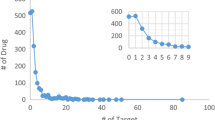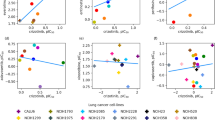Abstract
To make better use of all kinds of knowledge to predict drug synergy, it is crucial to successfully establish a drug synergy prediction model and leverage the reconstruction of sparse known drug targets. Therefore, we present an in silico method that predicts the synergy scores of drug pairs based on multitask learning (DSML) that could fuse drug targets, protein–protein interactions, anatomical therapeutic chemical codes, a priori knowledge of drug combinations. To simultaneously reconstruct drug–target protein interactions and synergistic drug combinations, DSML benefits indirectly from the associations with relation through proteins. In cross-validation experiments, DSML improved the ability to predict drug synergy. Moreover, the reconstruction of drug–target interactions and the incorporation of multisource knowledge significantly improved drug combination predictions by a large margin. The potential drug combinations predicted by DSML demonstrate its ability to predict drug synergy.
Graphic Abstract





Similar content being viewed by others
References
Spiro Z, Kovacs IA, Csermely P (2008) Drug-therapy networks and the prediction of novel drug targets. J Biol 7(6):1–5. https://doi.org/10.1186/jbiol81
Chou TC (2010) Drug combination studies and their synergy quantification using the Chou-Talalay method. Can Res 70(2):440–446. https://doi.org/10.1158/0008-5472.CAN-09-1947
Lecca P, Priami C (2013) Biological network inference for drug discovery. Drug Discov Today 18(5):256–264. https://doi.org/10.1016/j.drudis.2012.11.001
Lötsch J, Geisslinger G (2011) Low-dose drug combinations along molecular pathways could maximize therapeutic effectiveness while minimizing collateral adverse effects. Drug Discov Today 16(23):1001–1006. https://doi.org/10.1016/j.drudis.2011.10.003
Meyer CT, Wooten DJ, Paudel BB, Bauer J, Hardeman KN, Westover D, Lovly CM, Harris LA, Tyson DR, Quaranta V (2019) Quantifying drug combination synergy along potency and efficacy axes. Cell Syst 8(2): 97–108. e116. https://doi.org/https://doi.org/10.1016/j.cels.2019.01.003
Robert C, Karaszewska B, Schachter J, Rutkowski P, Mackiewicz A, Stroiakovski D, Lichinitser M, Dummer R, Grange F, Mortier L (2015) Improved overall survival in melanoma with combined dabrafenib and trametinib. N Engl J Med 372(1):30–39. https://doi.org/10.1056/NEJMoa1412690
Jia J, Zhu F, Ma X, Cao ZW, Li YX, Chen YZ (2009) Mechanisms of drug combinations: interaction and network perspectives. Nat Rev Drug Discov 8(2):111–128. https://doi.org/10.1038/nrd2683
Liu H, Zhang W, Zou B, Wang J, Deng Y, Deng L (2020) DrugCombDB: a comprehensive database of drug combinations toward the discovery of combinatorial therapy. Nucleic Acids Res 48(D1):D871–D881. https://doi.org/10.1093/nar/gkz1007
Shekhar C (2008) In silico pharmacology: computer-aided methods could transform drug development. Chem Biol 15(5):413–414. https://doi.org/10.1016/j.chembiol.2008.05.001
Yu Y, Li M, Liu L, Li Y, Wang J (2019) Clinical big data and deep learning: applications, challenges, and future outlooks. Big Data Mining Anal 2(4): 288–305. https://doi.org/https://doi.org/10.26599/BDMA.2019.9020007
Zhao XM, Iskar M, Zeller G, Kuhn M, Van NV, Bork P (2011) Prediction of drug combinations by integrating molecular and pharmacological data. PLoS Comput Biol 7(12):e1002323. https://doi.org/10.1371/journal.pcbi.1002323
Zou J, Ji P, Zhao YL, Li LL, Wei YQ, Chen YZ, Yang SY (2012) Neighbor communities in drug combination networks characterize synergistic effect. Mol BioSyst 8(12):3185–3196. https://doi.org/10.1039/C2MB25267H
Cai J, Luo J, Wang S, Yang S (2018) Feature selection in machine learning: A new perspective. Neurocomputing 300:70–79. https://doi.org/10.1016/j.neucom.2017.11.077
Liu H, Zhang W, Nie L, Ding X, Zou L (2019) Predicting effective drug combinations using gradient tree boosting based on features extracted from drug-protein heterogeneous network. BMC Bioinformatics 20(1):1–12. https://doi.org/10.1186/s12859-019-3288-1
Sheng Z, Sun Y, Yin Z, Tang K, Cao Z (2017) Advances in computational approaches in identifying synergistic drug combinations. Brief Bioinform 19(6):1172–1182. https://doi.org/10.1093/bib/bbx047
Li S, Zhang B, Zhang N (2011) Network target for screening synergistic drug combinations with application to traditional Chinese medicine. BMC Syst Biol 5(S1):S10. https://doi.org/10.1186/1752-0509-5-S1-S10
Lee JH, Kim DG, Bae TJ, Rho K, Kim JT, Lee JJ, Jang Y, Kim BC, Park KM, Kim S (2012) CDA: combinatorial drug discovery using transcriptional response modules. PLoS ONE 7(8):e42573. https://doi.org/10.1371/journal.pone.0042573
Yang J, Tang H, Li Y, Zhong R, Wang T, Wong S, Xiao G, Xie Y (2015) DIGRE: drug-induced genomic residual effect model for successful prediction of multidrug effects. CPT Pharmacometr Syst Pharmacol 4(2):91–97. https://doi.org/10.1002/psp4.1
Bansal M, Yang J, Karan C, Menden MP, Costello JC, Tang H, Xiao G, Li Y, Allen J, Zhong R (2014) A community computational challenge to predict the activity of pairs of compounds. Nat Biotechnol 32(12):1213–1222. https://doi.org/10.1038/nbt.3052
Xu KJ, Song J, Zhao XM (2012) The drug cocktail network. BMC Syst Biol 6(1):S5. https://doi.org/10.1186/1752-0509-6-S1-S5
Wang YY, Xu KJ, Song J, Zhao XM (2012) Exploring drug combinations in genetic interaction network. BMC Bioinformatics 13(7):S7. https://doi.org/10.1186/1471-2105-13-S7-S7
Xu Q, Xiong Y, Dai H, Kumari KM, Xu Q, Ou HY, Wei DQ (2017) PDC-SGB: Prediction of effective drug combinations using a stochastic gradient boosting algorithm. J Theor Biol 417:1–7. https://doi.org/10.1016/j.jtbi.2017.01.019
Sun Y, Sheng Z, Ma C, Tang K, Zhu R, Wu Z, Shen R, Feng J, Wu D, Huang D (2015) Combining genomic and network characteristics for extended capability in predicting synergistic drugs for cancer. Nat Commun 6(1):1–10. https://doi.org/10.1038/ncomms9481
Chen X, Ren B, Chen M, Wang Q, Zhang L, Yan G (2016) NLLSS: predicting synergistic drug combinations based on semi-supervised learning. PLoS Comput Biol 12(7):e1004975. https://doi.org/10.1371/journal.pcbi.1004975
Ding P, Yin R, Luo J, Kwoh CK (2019) Ensemble prediction of synergistic drug combinations incorporating biological, chemical, pharmacological and network knowledge. IEEE J Biomed Health Inform 23(3):1336–1345. https://doi.org/10.1109/JBHI.2018.2852274
Ding P, Ouyang W, Luo J, Kwoh CK (2020) Heterogeneous information network and its application to human health and disease. Brief Bioinform 21(4):1327–1346. https://doi.org/10.1093/bib/bbz091
Zhang X, Song J, Bork P, Zhao X (2016) The exploration of network motifs as potential drug targets from post-translational regulatory networks. Sci Rep 6(1):20558–20558. https://doi.org/10.1038/srep20558
Wang Y, Nacher JC, Zhao X (2012) Predicting drug targets based on protein domains. Mol BioSyst 8(5):1528–1534. https://doi.org/10.1039/c2mb05450g
Zeng X, Zhu S, Hou Y, Zhang P, Li L, Li J, Huang LF, Lewis SJ, Nussinov R, Cheng F (2020) Network-based prediction of drug-target interactions using an arbitrary-order proximity embedded deep forest. Bioinformatics 36(9):2805–2812. https://doi.org/10.1093/bioinformatics/btaa010
Zeng X, Zhu S, Lu W, Liu Z, Huang J, Zhou Y, Fang J, Huang Y, Guo H, Li L (2020) Target identification among known drugs by deep learning from heterogeneous networks. Chem Sci 11:1775–1797. https://doi.org/10.1039/c9sc04336e
Liu Y, Wei Q, Yu G, Gai W, Li Y, Chen X (2014) DCDB 2.0: a major update of the drug combination database. Database. https://doi.org/10.1093/database/bau124
Cheng F, Li W, Wu Z, Wang X, Zhang C, Li J, Liu G, Tang Y (2013) Prediction of polypharmacological profiles of drugs by the integration of chemical, side effect, and therapeutic space. J Chem Inf Model 53(4):753–762. https://doi.org/10.1021/ci400010x
Wishart DS, Feunang YD, Guo AC, Lo EJ, Marcu A, Grant JR, Sajed T, Johnson D, Li C, Sayeeda Z (2017) DrugBank 5.0: a major update to the DrugBank database for 2018. Nucleic Acids Res 46(D1):D1074–D1082. https://doi.org/10.1093/nar/gkx1037
Keshava Prasad T, Goel R, Kandasamy K, Keerthikumar S, Kumar S, Mathivanan S, Telikicherla D, Raju R, Shafreen B, Venugopal A (2008) Human protein reference database—2009 update. Nucleic Acids Res 37(S1):D767–D772. https://doi.org/10.1093/nar/gkn892
Asur S, Ucar D, Parthasarathy S (2007) An ensemble framework for clustering protein–protein interaction networks. Bioinformatics 23(13):i29–i40. https://doi.org/10.1093/bioinformatics/btm212
Cao B, Luo J, Liang C, Wang S, Ding P (2016) Pce-fr: a novel method for identifying overlapping protein complexes in weighted protein-protein interaction networks using pseudo-clique extension based on fuzzy relation. IEEE Trans Nanobiosci 15(7):728–738. https://doi.org/10.1109/TNB.2016.2611683
Lei C, Ruan J (2013) A novel link prediction algorithm for reconstructing protein–protein interaction networks by topological similarity. Bioinformatics 29(3):355–364. https://doi.org/10.1093/bioinformatics/bts688
Li A, Horvath S (2007) Network neighborhood analysis with the multi-node topological overlap measure. Bioinformatics 23(2):222–231. https://doi.org/10.1093/bioinformatics/btl581
Lei C, Tamim S, Bishop AJ, Ruan J (2013) Fully automated protein complex prediction based on topological similarity and community structure. Proteome Sci 11(1):1–8. https://doi.org/10.1186/1477-5956-11-S1-S9
Zhao Y, Chen X, Yin J (2018) A novel computational method for the identification of potential miRNA-disease association based on symmetric non-negative matrix factorization and Kronecker regularized least square. Front Genet 9:324. https://doi.org/10.3389/fgene.2018.00324
Wang F, Huang ZA, Chen X, Zhu Z, Wen Z, Zhao J, Yan GY (2017) LRLSHMDA: Laplacian regularized least squares for human microbe–disease association prediction. Sci Rep 7(1):1–11. https://doi.org/10.1038/s41598-017-08127-2
Gui J, Huang DS, You Z (2008) An improvement on learning with local and global consistency. Int Conf Pattern Recogn 19:1–4. https://doi.org/10.1109/ICPR.2008.4761295
Luo J, Ding P, Liang C, Chen X (2018) Semi-supervised prediction of human miRNA-disease association based on graph regularization framework in heterogeneous networks. Neurocomputing 294:29–38. https://doi.org/10.1016/j.neucom.2018.03.003
Long M, Wang J, Ding G, Shen D, Yang Q (2014) Transfer learning with graph co-regularization. IEEE Trans Knowl Data Eng 26(7):1805–1818. https://doi.org/10.1109/TKDE.2013.97
Ding P, Shen C, Lai Z, Liang C, Li G, Luo J (2020) Incorporating multisource knowledge to predict drug synergy based on graph co-regularization. J Chem Inf Model 60(1):37–46. https://doi.org/10.1021/acs.jcim.9b00793
Petegrosso R, Park S, Hwang TH, Kuang R (2016) Transfer learning across ontologies for phenome–genome association prediction. Bioinformatics 33(4):529–536. https://doi.org/10.1093/bioinformatics/btw649
Ezzat A, Zhao P, Wu M, Li XL, Kwoh CK (2017) Drug-target interaction prediction with graph regularized matrix factorization. IEEE/ACM Trans Comput Biol Bioinf 14(3):646–656. https://doi.org/10.1109/TCBB.2016.2530062
Bottou L (2010) Large-scale machine learning with stochastic gradient descent. In Proceedings of COMPSTAT'2010. 19: 177–186. https://doi.org/https://doi.org/10.1007/978-3-7908-2604-3_16
Shen C, Luo J, Ouyang W, Ding P, Chen X (2020) IDDkin: Network-based influence deep diffusion model for enhancing prediction of kinase inhibitors. Bioinformatics. https://doi.org/10.1093/bioinformatics/btaa1058
Lin X, Quan Z, Wang ZJ, Ma T, Zeng X (2020) KGNN: knowledge graph neural network for drug-drug interaction prediction. Int Joint Conf Artif Intell 29:2739–2745
Chen H, Cheng F, Li J (2020) iDrug: integration of drug repositioning and drug-target prediction via cross-network embedding. PLoS Comput Biol 16(7):e1008040. https://doi.org/10.1371/journal.pcbi.1008040
Zeng X, Zhu S, Liu X, Zhou Y, Cheng F (2019) deepDR: a network-based deep learning approach to in silico drug repositioning. Bioinformatics 35(24):5191–5198. https://doi.org/10.1093/bioinformatics/btz418
Muschelli J (2020) ROC and AUC with a binary predictor: a potentially misleading metric. J Classif 37(3):696–708. https://doi.org/10.1007/s00357-019-09345-1
Davis J, Goadrich M (2006) The relationship between Precision-Recall and ROC curves. Int Conf Mach Learn 23:233–240. https://doi.org/10.1145/1143844.1143874
Fan J, Cheng J (2018) Matrix completion by deep matrix factorization. Neural Netw 98:34–41. https://doi.org/10.1016/j.neunet.2017.10.007
Chen H, Li J (2019) Modeling Relational Drug-target-disease interactions via tensor factorization with multiple web sources. World Wide Web Conf 19:218–227. https://doi.org/10.1145/3308558.3313476
Wan F, Hong L, Xiao A, Jiang T, Zeng J (2019) NeoDTI: neural integration of neighbor information from a heterogeneous network for discovering new drug-target interactions. Bioinformatics 35(1):104–111. https://doi.org/10.1093/bioinformatics/bty543
Gennatas C, Michalaki V, Mouratidou D, Tsavaris N, Andreadis C, Photopoulos A, Voros D (2006) Gemcitabine combined with 5-fluorouracil for the treatment of advanced carcinoma of the pancreas. In vivo 20(2):301–305. https://doi.org/10.1089/hum.2006.17.362
Gutierrez-Delgado F, Lopez-Mariscal A, Maldonado-Hernandez H, Luna-Benitez I, Salazar-Macias F, Aceves-Escarcega A, Delgadillo-Hernandez (2005) Oxaliplatin and cyclophosphamide as neoadjuvant chemotherapy (NACT) followed by surgery for patients with locally advanced cervical cancer (LACC). A preliminary report. J Clin Oncol 23(16_suppl): 5173–5173. https://doi.org/https://doi.org/10.1200/jco.2005.23.16_suppl.5173
Montagna E, Cancello G, Bagnardi V, Pastrello D, Dellapasqua S, Perri G, Viale G, Veronesi P, Luini A, Intra M (2012) Metronomic chemotherapy combined with bevacizumab and erlotinib in patients with metastatic HER2-negative breast cancer: clinical and biological activity. Clin Breast Cancer 12(3):207–214. https://doi.org/10.1016/j.clbc.2012.03.008
Ketter TA, Pazzaglia PJ, Post ARM (1992) Synergy of carbamazepine and valproic acid in affective illness: case report. J Clin Psychopharmacol 12(4):276–281. https://doi.org/10.1097/00004714-199208000-00011
Chen X, Xie W, Xiao P, Zhao X, Yan H (2017) mTD: a database of microRNAs affecting therapeutic effects of drugs. J Genet Genomics 44(5):269–271. https://doi.org/10.1016/j.jgg.2017.04.003
Davis AP, Grondin CJ, Johnson RJ, Sciaky D, King BL, McMorran R, Wiegers J, Wiegers T, CMattingly C. (2016) The comparative toxicogenomics database: update 2017. Nucleic Acids Res 45(D1):D972–D978. https://doi.org/10.1093/nar/gkw838
Acknowledgements
This work has been supported by the National Natural Science Foundation of China (Grant Nos. 62002154, 61873089, and 61502221), Hunan Provincial Natural Science Foundation of China (Grant No. 2019JJ50520), Research Foundation of Hunan Educational Committee (Grant No. 20C1579), and Scientific Research Startup Foundation of University of South China (Grant No. 190XQD096).
Author information
Authors and Affiliations
Corresponding author
Ethics declarations
Conflict of Interest
The authors declare that they have no conflicts of interest.
Supplementary Information
Below is the link to the electronic supplementary material.
Rights and permissions
About this article
Cite this article
Chen, X., Luo, L., Shen, C. et al. An In Silico Method for Predicting Drug Synergy Based on Multitask Learning. Interdiscip Sci Comput Life Sci 13, 299–311 (2021). https://doi.org/10.1007/s12539-021-00422-x
Received:
Revised:
Accepted:
Published:
Issue Date:
DOI: https://doi.org/10.1007/s12539-021-00422-x




